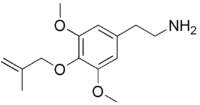Methallylescaline
This is an old revision of this page, as edited by Edgar181 (talk | contribs) at 15:44, 28 March 2018. The present address (URL) is a permanent link to this revision, which may differ significantly from the current revision.

| |
| Names | |
|---|---|
| IUPAC name
2-{3,5-dimethoxy-4-[(2-methylprop-2-en-1-yl)oxy]phenyl}ethanamine
| |
| Identifiers | |
3D model (JSmol)
|
|
| ChEMBL | |
| ChemSpider |
|
CompTox Dashboard (EPA)
|
|
| |
| |
| Properties | |
| C14H21NO3 | |
| Molar mass | 251.326 g·mol−1 |
Except where otherwise noted, data are given for materials in their standard state (at 25 °C [77 °F], 100 kPa).
| |
Methallylescaline (4-methylallyloxy-3,5-dimethoxyphenethylamine) is a lesser-known psychedelic drug. It is also the 4-methyl analog of allylescaline. Methallylescaline was first synthesized by Alexander Shulgin. In his book PiHKAL (Phenethylamines i Have Known And Loved), the dosage range is listed as 40–65 mg and the duration is listed as 12–16 hours.[1] Very little data exists about the pharmacological properties, metabolism, and toxicity of methallylescaline.
Legal status
Allylescaline is illegal in Sweden as of 26 January 2016.[2]
See also
References
- ^ Methallylescaline entry in PiHKAL
- ^ "31 nya ämnen kan klassas som narkotika eller hälsofarlig vara" (in Swedish). Folkhälsomyndigheten. November 2015.
| Phenethylamines |
|
|---|---|
| Amphetamines |
|
| Phentermines |
|
| Cathinones |
|
| Phenylisobutylamines | |
| Phenylalkylpyrrolidines | |
| Catecholamines (and close relatives) |
|
| Miscellaneous |
|
This psychoactive drug-related article is a stub. You can help Wikipedia by expanding it. |
